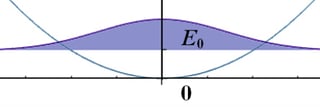What is the biggest known difference between $r_e$ and $r_0$? Where $r_0$ is the average bond length of the lowest vibrational state,
and $r_e$ is the location where the potential is lowest.
For a perfect harmonic oscillator, these are the same (notice that the peak probability is exactly at the minimum of the potential):
What is the largest known difference between $r_e$ and $r_0$ in a real molecule?
This is important because the CRC Handbook on Chemistry and Physics almost always gives $r_0$ because that's what can be determined more easily from experiment, but ab initio geometry optimization almost always gives $r_e$, yet many publications do not even say which type of bond length they are reporting.

